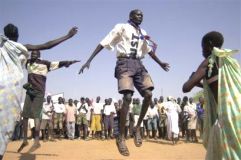1.7 million displaced return to South Sudan – report
October 25, 2008 (GENEVA) — Around 1.7 million Internally Displaced Persons (IDPs) have returned to southern Sudan since the signing of a peace agreement between the Sudanese government and a former rebel group ending two decades of war in 2005.
 Some four millions people were displaced from or within southern Sudan during the 20 years of war in the south, said a report of the Sudan Joint Mission issued in March 2005.
Some four millions people were displaced from or within southern Sudan during the 20 years of war in the south, said a report of the Sudan Joint Mission issued in March 2005.
According to a 42 pages report released on Friday, 1.7 million Southern Sudanese returned home following the signing of the Comprehensive Peace Agreement until the end of June 2008, an international aid agency said.
According to IOM estimates, Northern Bahr el Ghazal has received the largest number of returns with an estimated 401,763 returnees (22 %) followed by Southern Kordofan with 298,098 returnees (16%) while Eastern Equatoria and Western Bahr el Ghazal states received the lowest number of returnees with 53,395 returnees (3%) and 62,304 returnees (3%) respectively.
About 60 percent of the families returning to southern Sudan are headed by single women, and 59 percent of the returnees are children aged 5 to 17, the International Organisation for Migration (IOM) said.
An assessment in March 2005, shortly after the peace agreement was signed, estimated 4 million people had been displaced from or within southern Sudan by 20 years of fighting between the north and south of the country.
According to an IOM report, based on interviews with 875,000 internally displaced people during their return journey, 75 percent used buses or trucks to get home, 17 percent walked, 5 percent travelled by boat and 3 percent travelled by plane.
IOM spokeswoman Jemini Pandya said it was a positive sign that people started heading back to their war-ravaged homeland “almost immediately” after the peace agreement was signed.
“There is a kind of confidence and a return of faith in the future of South Sudan,” she said.
Detailed information about those seeking to re-establish themselves in the region should help aid workers and government authorities plan assistance programmes, covering food, shelter, health care and other vital needs, according to the IOM.
“Tracking spontaneous returns, particularly at the village level, provides important information on the reintegration needs of vulnerable individuals and families,” its Sudan mission chief, Mario Tavolaj, said in a statement.
“It also represents an important tool for planning medium to long-term recovery in Southern Sudan.”
(ST)
The full report is available at the IOM website
